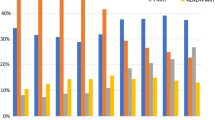Abstract
Purpose
We sought to compare the number of lymph nodes (LN) resected in axillary lymph node dissections (ALND) and sentinel lymph node dissections (SLND), and to assess the validity of registry reporting for axillary staging in breast cancer.
Methods
Women in the California Cancer Registry who underwent surgical axillary staging for T1/T2, M0 breast cancer between 2004 and 2008 were evaluated. The number of LN resected in patients reported as having SLND+ALND and ALND were assessed for compliance with 6 and 10 LN threshold definitions for ALND. The proportion of patients with ≤3 LN removed was assessed for patients receiving SLND only.
Results
Of 71,907 patients, 45.5 % had SLND, 24.0 %, SLND+ALND, and 30.5 %, ALND. The median number of LN resected with SLND cases was 2 (range 1–41); SLND+ALND, 9 (range 1–63); and ALND, 11 (range 1–81) (p < 0.0001). Of patients undergoing ALND, 56.7 % had ≥10 LN removed; 46.2 % of patients with SLND+ALND had ≥10 LN removed (p < 0.0001). Overall, 75.5 % of patients with ALND had ≥6 LN removed and 67.8 % of patients with SLND+ALND had ≥6 LN removed (p < 0.0001). Of those receiving only SLND, 83.4 % had ≤3 LN removed.
Conclusions
A significant proportion of patients did not meet the minimum LN count thresholds for full ALND or had excess LN removed in a SLND. Further investigation is required to determine whether absolute LN number or reported operative procedure and implied surgical technique better defines axillary staging in a registry database.
Similar content being viewed by others
References
American College of Surgeons. National Accreditation Program for Breast Centers. Breast center standards manual. http://napbc-breast.org/standards/2012standardsmanual.pdf. Accessed 15 Apr 2012.
Soper NJ, Kaufman DB, eds. Northwestern handbook of surgical procedures. 2nd ed. Austin, TX: Landes Bioscience, 2011.
Zollinger RMJ, Zollinger RM. Atlas of surgical operations. New York: MacGraw-Hill, 1993.
Axelsson CK, Mouridsen HT, Zedeler K. Axillary dissection of level I and II lymph nodes is important in breast cancer classification. The Danish Breast Cancer Cooperative Group (DBCG). Eur J Cancer. 1992;28A:1415–8.
Giuliano AE, Hunt KK, Ballman KV, et al. Axillary dissection vs. no axillary dissection in women with invasive breast cancer and sentinel node metastasis: a randomized clinical trial. JAMA. 305:569–75.
Krag DN. Training manual for NSABP B-32. Pittsburgh, 1999.
Morton DL, Wen DR, Wong JH, et al. Technical details of intraoperative lymphatic mapping for early stage melanoma. Arch Surg. 1992;127:392–9.
Giuliano AE, Kirgan DM, Guenther JM, Morton DL. Lymphatic mapping and sentinel lymphadenectomy for breast cancer. Ann Surg. 1994;220:391–8.
Krag DN, Weaver DL, Alex JC, Fairbank JT. Surgical resection and radiolocalization of the sentinel lymph node in breast cancer using a gamma probe. Surg Oncol. 1993;2:335–9.
McMasters KM, Tuttle TM, Carlson DJ, et al. Sentinel lymph node biopsy for breast cancer: a suitable alternative to routine axillary dissection in multi-institutional practice when optimal technique is used. J Clin Oncol. 2000;18:2560–6.
American Society of Breast Surgeons. Guidelines for performing sentinel lymph node biopsy in breast cancer. http://breastsurgeons.org/statements/2010-Nov-05_on_Performing_SLND.pdf. Accessed 15 Apr 2012.
Chagpar AB, Scoggins CR, Martin RC 2nd, et al. Factors determining adequacy of axillary node dissection in breast cancer patients. Breast J. 2007;13:233–7.
Olaya W, Wong J, Morgan JW, et al. Factors associated with variance in compliance with a sentinel lymph node dissection quality measure in early-stage breast cancer. Ann Surg Oncol. 2010;17(3):297–302.
Krag DN, Anderson SJ, Julian TB, et al. Technical outcomes of sentinel-lymph-node resection and conventional axillary-lymph-node dissection in patients with clinically node-negative breast cancer: results from the NSABP B-32 randomised phase III trial. Lancet Oncol. 2007;8:881–8.
Yi M, Meric-Bernstam F, Ross MI, et al. How many sentinel lymph nodes are enough during sentinel lymph node dissection for breast cancer? Cancer. 2008;113:30–7.
Zakaria S, Degnim AC, Kleer CG, et al. Sentinel lymph node biopsy for breast cancer: how many nodes are enough? J Surg Oncol. 2007;96:554–9.
Cil T, Hauspy J, Kahn H, et al. Factors affecting axillary lymph node retrieval and assessment in breast cancer patients. Ann Surg Oncol. 2008;15:3361–8.
Posther KE, McCall LM, Blumencranz PW, et al. Sentinel node skills verification and surgeon performance: data from a multicenter clinical trial for early-stage breast cancer. Ann Surg. 2005;242:593–9.
American College of Surgeons. Coding cancer registry items. Scope of regional lymph node surgery: a review of data validity, revised coding directives, and agency transition plans. http://www.facs.org/cancer/ncdb/scope-regional-lymph-node-surgery.pdf. Accessed 15 Apr 2012.
Acknowledgment
Supported in part by NCI/SEER contracts N01-PC-35136, N01-PC-35139, and N02-PC-15105; CDC/National Program for Cancer Registries contract U58DP000807-01; and the California Department of Public Health, Cancer Surveillance Branch.
Author information
Authors and Affiliations
Corresponding author
Rights and permissions
About this article
Cite this article
Olaya, W., Wong, J., Wong, J. et al. When is a Lymph Node Dissection a Lymph Node Dissection? The Number of Lymph Nodes Resected in Sentinel and Axillary Lymph Node Dissections. Ann Surg Oncol 20, 627–632 (2013). https://doi.org/10.1245/s10434-012-2642-6
Received:
Published:
Issue Date:
DOI: https://doi.org/10.1245/s10434-012-2642-6




